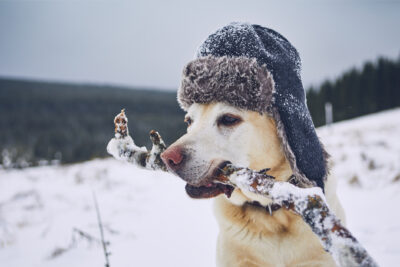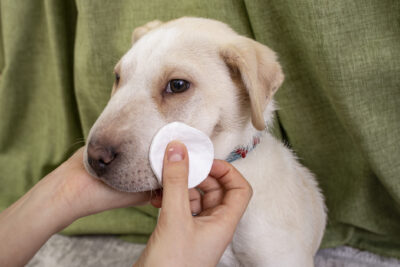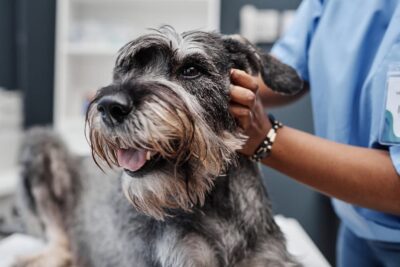Can Dogs Get Sunburn?

Overview
With many parts of the world suffering from extreme weather this year, veterinarians are expecting to see more cases of sun-related illnesses including heat stroke and sunburn. But can dogs get sunburn?
While many people think that dogs are protected from the sun by their coats, that’s only partially true. Dogs can – and do! – get sunburned.
In this article we’ll cover how to treat sunburn on dogs and answer the all-important question “do dogs need sunscreen?”
What Is a Sunburn?
Sunburn is a characteristic painful red reaction of the skin following prolonged, unprotected sun exposure. Increased blood flow to the area gives it the red color, but there are also changes to the skin cells themselves.
The sun gives out ultraviolet (UV) radiation. This radiation is known to be highly damaging to cells and DNA, and it’s everywhere. Although our skin is well adapted to cope with repeated exposure to this carcinogen, large amounts of UV radiation can still overwhelm the skin’s natural responses, resulting in a sunburn, a radiation burn caused by UV light.
Sunburn worries vets and doctors because damaged cells are prone to becoming cancerous. When sunlight damages the DNA of these cells, the tumor-suppressor gene p53 may be “switched off,” making skin cancer more likely.
Sunburn can be categorized into different degrees depending on how deep the burn goes.
- First-degree sunburn only affects the outer layer of the skin
- Second-degree burns affect much deeper into the skin.
- Third-degree burns affect deeper tissues and are severe. Third-degree burns from sunlight are extremely rare.
Can Dogs Get Sunburn?

Yes, dogs can get sunburned. Thanks to their coats, dogs get burned less regularly than people do. However, it’s certainly possible for dogs to get severe and painful burns just like their human counterparts.
Canine skin is quite similar to human skin and burns in just the same way, with a red and painful reaction.
If you’ve got a fair friend, you’ll know that pale skin burns badly! This is because melanin – the compound that causes dark skin – is protective against sunburn. Therefore, paler skin has less protection, and burns are more likely and often more severe. This is the same in dogs.
Dogs with dark fur often have darker skin and are more protected than those with light fur. Dogs do get some sun protection from their fur, which shades the skin and blocks the UV rays before they reach the outer layers of the skin. But where there’s less fur, this protection is lost.
This means that dogs are more likely to get sunburn if they have:
- No fur (like the Mexican Hairless)
- Very short fur (like Greyhounds and Chihuahuas)
- Bald patches or clipped areas after surgery
- Light-colored fur and skin
The areas that get the most sun are most prone to sunburn. Thin-haired areas on the back and head are most at risk – the ears, the nose, and any bald patches on the back are classic areas for dogs to get sunburned. A dog’s stomach rarely gets burned, even though it’s an area of the body with thin hair.
Sunburn Symptoms on Dogs

Sunburn in dogs is very similar to sunburn in humans. But because of their fur, it might be a little harder to see.
You might notice red patches on any hairless areas. Similarly, a sunburned dog may be sensitive to touch or even itchy over the area.
Other signs of sunburn in dogs include:
- Reaction to being petted (painful skin)
- Skin that is pink or even red
- Itchiness
- Peeling skin (seen as flakes)
In severe cases, you may see blisters, hair loss, and skin infections. Dogs can also develop fevers and increased panting.
Do Dogs Need Sunscreen?
Yes, sunscreen that is formulated specifically for dogs is recommended if you and your dog plan on spending time outdoors without access to shaded areas. This may include beach days, hiking trips, or dog-park visits on sunny, hot days.
Sunscreen is especially important for hairless breeds or light-colored dogs. However, it is a good idea to put sunscreen on all dogs, regardless of their coat type, as a preventive measure.
Do not use human sunscreen on dogs. Human sunblock may include toxic ingredients for dogs and can be harmful if your dog licks or ingests it. Repeated exposure to zinc oxide can lead to a zinc toxicity and affect red blood cells. Products containing salicylates can cause skin redness and irritation.
Dog Sunburn Treatment
Most mild cases of dog sunburn can be treated at home. However, it’s important to contact your veterinarian for an appointment if your dog has any of the signs of severe sunburn or if their skin isn’t improving after 48 hours.
It’s also imperative that you take your dog to the nearest open veterinary clinic or emergency hospital immediately if your dog is showing any signs of heatstroke, which often goes hand-in-hand with sunburn.
At home, you should take your dog out of the sun as soon as you notice any signs of sunburn. You may be able to relieve some of the discomfort with a cold bath or cold compresses. However, you should never leave wet towels on your dog as this can cause them to heat up. Try to maintain skin moisture – moisturizing shampoos are best if you have to wash your dog’s coat. Soothing aloe vera can be applied to the area, but it’s important to get a product that is safe for sunburned dogs. If your dog has nose sunburn, try not to apply any creams as it’s likely they’ll simply lick them off. You also shouldn’t apply any products to broken or blistered skin – this is severe sunburn and needs veterinary attention.
If you have to visit a veterinary clinic for a dog sunburn, your vet will similarly apply cooling and soothing products to red skin that isn’t severely damaged. However, they will be more concerned with treating severe skin burns and may recommend medications such as pain relief and antibiotics as well as wound treatment.
How to Prevent Dog Sunburns

There are things you can do to mitigate your dog’s risk of getting a sunburn. Follow these tips to keep your dog’s skin safe:
Watch the weather forecast. If you have a dog who is at risk of sunburn, you should watch the UV forecast. When it’s medium or high, it’s time to get out the sun protection for your dog. If you have to go outdoors, avoid the sun during hours when it is the strongest – typically between 11 a.m. and 3 p.m.
Apply sunscreen. Protect any exposed areas with sunblock for dogs. This should be applied to ears, bald patches, and anywhere else you’re worried that your dog might burn. It’s very important to use a product specifically designed for pets, as many human sunscreens are toxic if your dog licks them. Aim for dog sunblock with SPF 30 or more, as dog skin doesn’t naturally have much protection against the sun. Apply dog sunscreen 20 minutes before going out and reapply regularly, especially if they’ve been swimming.
Consider protective clothing. Where larger areas of skin are at risk, such as with Mexican Hairless dogs or those suffering with generalized alopecia, you should invest in protective clothing. Just as beach clothing for babies, this provides a thin layer that keeps your dog’s skin safe from the sun. Just remember that, although the layer is thin, it still traps some heat. You should still be aware that your dog could be at risk of heatstroke.
Avoid the sun for ultimate protection. It’s always best to avoid the sun when you can. Sunburn is not the only risk on warm-weather days. Heatstroke can quickly happen in the sun and it does kill dogs every year. Wherever possible, keep your dog in a cool house (with a fan on or air conditioning running) on extremely warm days.









